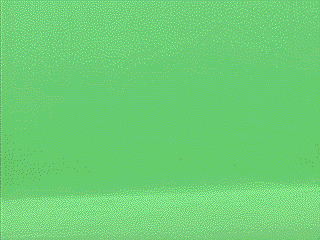Imperfections in the backing, from improper lighting, poor patch jobs, or uneven texturing, can cause luminance differences that will effect the final composite. These imperfections reveal themselves in patches of brightness that show up in the background plate in the composite. The easiest way to counter these unwanted effects is to shoot a screen correction shot on location for every shot you will composite.


An effective screen correction shot.
Ultimatte takes the screen correction shot, and compares it to the backing in your foreground shot, creating a new corrected background image that is flawless.
Do's
- Photograph the screen correction with your backing and foreground lighting on.
- A screen correction shot is a camera roll of your backing without the foreground subject.
- After shooting the screen correction, then roll the camera with the subject in the frame.
- All Camera moves need to be done with a motion control rig.
- For screen correction to work properly, every aspect of the screen correction shot and the subject matter shot need to be match.
- Orientation, position, and angle of the camera need to be rock solid in sync.
- Lighting in both the screen correction and the foreground footage need to be exactly the same.
- Move the camera without a motion control rig.
- Change your lighting